
© Railway Wonders of the World 2012-


The Story of the Southern
London’s Link with the South Coast
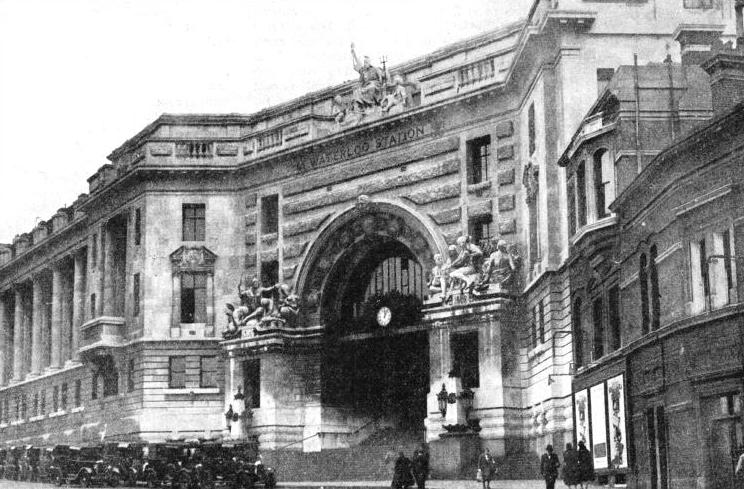
THE MAIN ENTRANCE TO WATERLOO STATION, which has twenty-
THE Southern Railway is the smallest of the four great railways brought into being by the Railways Act of 1921. Its route mileage is only 2,186, all, except nineteen miles, of standard gauge. But it has many claims to fame. It owns the largest passenger station in the British Isles, as well as the one with the greatest number of trains a day. Its traffic is denser than that of any of the other British railways. It owns the chief passenger port in the kingdom, in addition to claiming the lion’s share of cross-
The Southern is pre-
From the geographical standpoint, the Southern Railway is much the most compact of the British systems. An exceptionally large proportion of its mileage is within twenty-
In its present form the Southern consists of a number of undertakings that were amalgamated in 1923 as a result of the Railways Act of 1921. These undertakings had themselves absorbed several smaller railways in the distant past, including the London and Greenwich Railway, which was -
The main framework of the system consists of four important railways -
Other lines absorbed in 1923 included the Plymouth, Devonport and South Western Junction, the miniature Lynton and Barnstaple, and the three railways in the Isle of Wight -
Tentacles to the Coast
The system radiates from London and extends to the coasts of Kent, Sussex, Hampshire, Dorset, and Devonshire. From Sheerness to Bournemouth it has virtually a railway monopoly. Farther west it shares the traffic with the Great Western, as at Exeter and Plymouth. One long branch stretches through Devonshire to Ilfracombe, and another ends at the Cornish port of Padstow. As the joint owner with the LMS of the Somerset and Dorset, the Southern Railway has interests as far afield as Bath and Burnham-
As the South Eastern Railway took over the London and Greenwich line in 1845, it must be regarded as the oldest of the lines comprised in the Southern. It may also claim seniority by virtue of its ownership of a still older line -
This little line was opened in May, 1830. and thus slightly antedated the Liverpool and Manchester Railway. Many people may have been puzzled why two such comparatively small places as Whitstable and Canterbury should have had the benefits of railway communication at so early a date -
The Canterbury and Whitstable, which was sanctioned by Parliament as early as 1825, was only ten miles in length. It is doubtful whether any other railway of such small size was ever worked simultaneously by so many different forms of motive power. These originally comprised three fixed engines, horses, and a single locomotive, the variety being due to the undulations of the line.
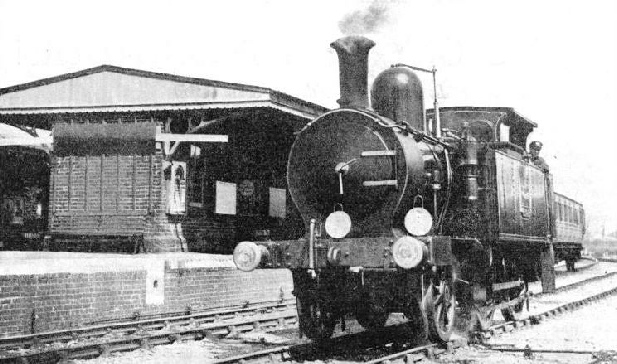
A VETERAN LOCOMOTIVE. One of the oldest engines on the Southern system is the “Ryde”, built in 1864. The locomotive, which has attained a total mileage of over one and a half millions, operates in the Isle of Wight, and is here seen at Brading.
The first engine, it may be recalled, was the historic “Invicta”, built by Robert Stephenson. This locomotive, which was the second to leave the Stephenson factory, was similar in general design to the “Rocket”, save that its four wheels were coupled. It is still preserved, and reposes to-
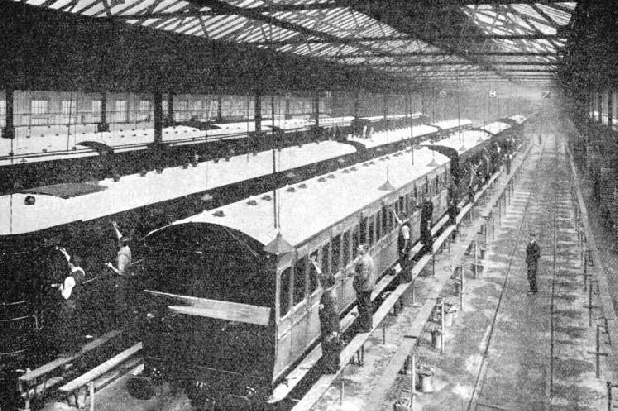
IN THE SHOPS. Rows of coaches owned by the Southern Railway receiving a fresh coat of paint in the Company's works at Lancing, Sussex. The Southern Railway has over 6,600 coaching vehicles, nearly 33,600 freight vehicles, and over 2,000 electric vehicles.
Soon after the Canterbury and Whitstable Railway was opened, its operation by locomotives was suspended, but on its being leased to the South Eastern Railway in 1844 it was re-
The dimensions restricted the size of the rolling-
The story of the tunnel is worth re-
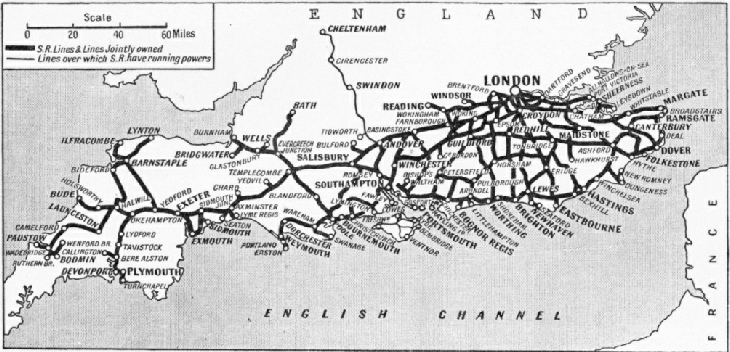
But to return to the South Eastern proper, with whose history, it should be pointed out, that of the London, Brighton and South Coast, as well as the London, Chatham and Dover, was associated from very early days. In 1825, when the Stockton and Darlington was opened, and the project for a railway between Liverpool and Manchester was getting itself very much talked about, the idea arose, “Why not also a railway from London to Dover?” A number of schemes were put forward, including one in 1833 for a line via Maidstone, but the determined opposition of powerful vested interests defeated them all.
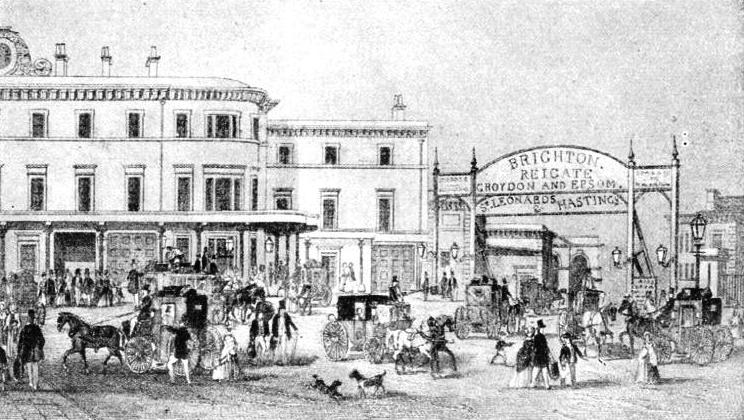
LONDON BRIDGE STATION as it appeared many years ago. The building on the left is part of the South Eastern station; the London, Brighton and South Coast station is seen on the right. Both these railways are now absorbed in the Southern Railway.
Then, in 1835, the London and Croydon Company -
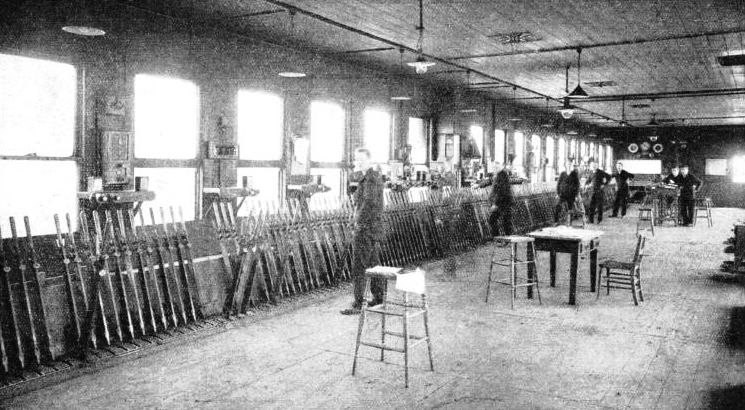
OUTSIDE WATERLOO STATION, the “A” signal box, in the centre of a large bridge of signals, controls the station approach. The 266 levers are manually operated. Over 1,550 trains are handled daily at this great station.
Eventually a compromise was reached, whereby the Brighton Company made a line from Redhill to Norwood Junction, on the London and Croydon, the South Eastern paying half the cost, and becoming owners of the southern portion as far as Coulsdon. On the opening of the line, South-
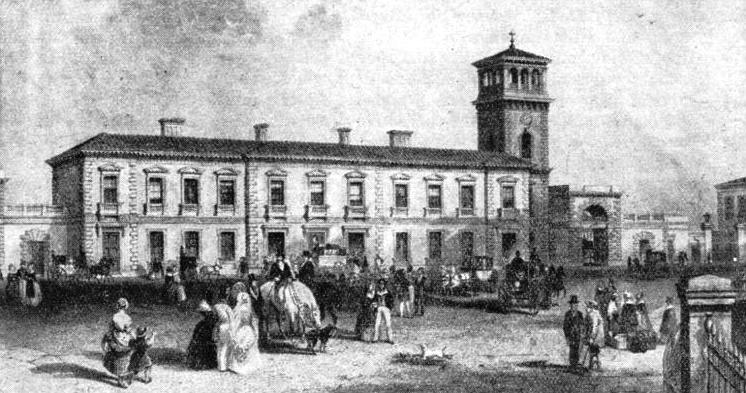
THE LONDON TERMINUS of the early railway to Brighton and Dover. This station was the predecessor of the modern London Bridge Station, and was demolished about 1850. The railway between London and Brighton was completed in 1841.
These tunnels were driven through the chalk. Instead of the customary practice of sinking vertical shafts from the top, Cubitt chose the method of driving horizontal galleries. The work involved the blowing away of the face of Round Down Cliff, for which purpose 18,000 pounds of gunpowder were used. It is of historical interest to recall that this was one of the first recorded instances of firing an explosive agent by electricity. The resulting upheaval covered over fifteen acres with fragments of chalk.
By May, 1842, the first South Eastern trains were able to run through between London and Tonbridge, and later in the same year the line had reached Ashford, where the locomotive shops are situated. A year later the line was opened to Folkestone, and in the year after that Dover was at length reached, and the first London branch was also opened. This ended at Bricklayers’ Arms Station, which was originally known as the company’s “West End Station”, although on the south side of the Thames. It is now used as a goods depot. Regular passenger traffic was worked in and out of Bricklayers’ Arms until the beginning of 1852. The station re-
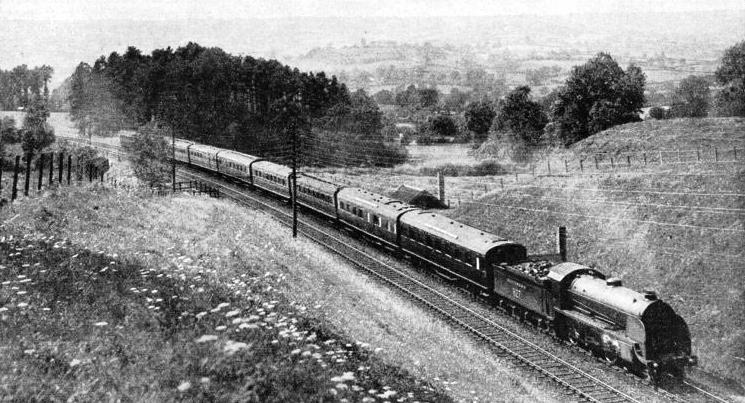
A WEST OF ENGLAND EXPRESS climbing the formidable Honiton bank to the west of Salisbury. The seven-
The London, Chatham and Dover Railway traces its history back to 1853. In that year the East Kent Railway (bearing the Kentish motto, “Invicta”) was incorporated, with the object of building a line from Strood (Rochester) to Canterbury, both served by the South Eastern Railway. This line owed its origin to a scheme for developing a building estate at Herne Bay. The estate had been bought by one George Burge, in the hope that its value would be enhanced by the construction of a railway in the neighbourhood. Burge became associated with two assistants of John Rennie, one of the best-
In 1859 the East Kent changed its name and became the London, Chatham and Dover Railway. The line to Faversham had been opened during the previous year, and that to Canterbury was finished in 1860. In the meantime, Parliament had sanctioned the construction of extensions from Canterbury to Dover and from Strood to St. Mary Cray, which had the effect of converting a small Kentish undertaking into a system closely approaching the fringe of the outer London suburban area. London itself was reached in November, 1861, over a complicated route. Between St. Mary Cray and Bromley this was over the Mid-
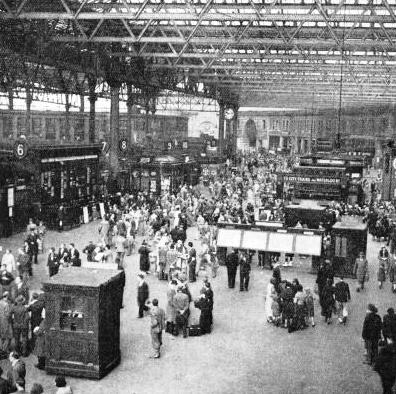
THE HEART OF THE SOUTHERN. Waterloo Station is the largest station in Great Britain, and occupies twenty-
This last concern, which maintained a separate legal existence until 1923, when it was absorbed by the Southern, was one of the many “non-
With the entry into London of the London, Chatham and Dover, there began that long era of competition with the South Eastern to which reference has already been made. The story is too long to tell here, but mention must be made of the fact that the South Eastern found or thought itself compelled to own a shorter main line, and in 1868 opened its new route to Tonbridge, via Sevenoaks. Four years before, it had finished the extension from London Bridge to Cannon Street and Charing Cross, and the provision of these additional terminal stations gave it a great advantage over all the other main lines entering London from the south. But it may be asked whether the superiority was not bought at too high a price, since the construction of only slightly over two and a half miles of railway cost the enormous sum of four million pounds.
The terminal station position was one of great importance in the struggle between the two systems. Thus, to counter the opening of the South Eastern’s Charing Cross Station in 1864, the London, Chatham and Dover opened Ludgate Hill in the same year. The South Eastern replied two years later with the more conveniently situated Cannon Street. The fight lasted for over thirty years. A good deal of the competition was of the same insensate nature as at a previous date had led to visitors to the Great Exhibition being brought by excursion from the provinces to London and back for the ridiculous sum of a shilling. But responsibility for this competition largely rested on the Parliaments that sanctioned the duplication of routes. In addition to Dover, where the prize was the very profitable cross-
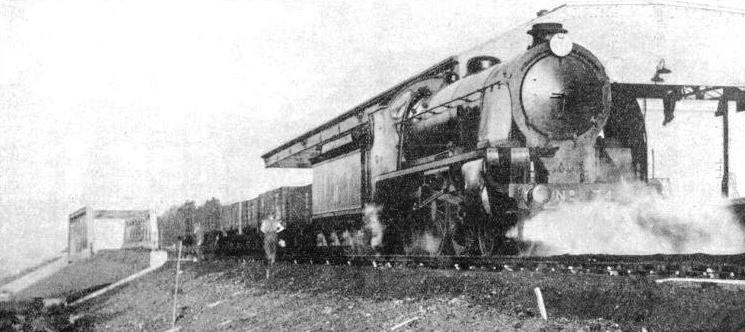
“IRONING-
It has already been shown how the fortunes of the Brighton Company, in virtue of its geographical situation, became linked up at an early date with those of the South Eastern and Chatham. Before the incorporation of the London and Croydon, Rennie had not only planned the construction of a railway from London to Brighton, but had also surveyed the route. This began at Kennington Park, and proceeded thence to Croydon, via Clapham and Streatham, whence the route to Brighton was much the same as that now in existence.
A Plan that Failed
To this main scheme were added subsidiary projects in the shape of a line from Nine Elms to Shoreham-
Even after this surgical operation, nothing came of the project at first, but it is noteworthy that Rennie was sufficiently far-
Nothing was done in 1836, but in the next year, after a Parliamentary battle in which Robert Stephenson’s bill was passed by the House of Commons, only to be thrown out by the Lords, Rennie’s scheme was sanctioned, with certain alterations. As amended, the route to Brighton started at a junction with the London and Croydon instead of at Kennington, and had branches to Lewes, Newhaven, and Shoreham. The London and Brighton Company were also obliged to buy up the Croydon, Merstham and Godstone extension of the Surrey Iron Railway. Since this line, which was opened for traffic in 1803, and was the first in the world to be built with Parliamentary sanction (the earlier colliery railways in the North of England not requiring any legislative authority for their construction and working), the Brighton system can also establish a claim to be the real origin of the Southern. But the Surrey line never used locomotive traction, and was not a public railway in the real sense, although it has on occasion been described as such.
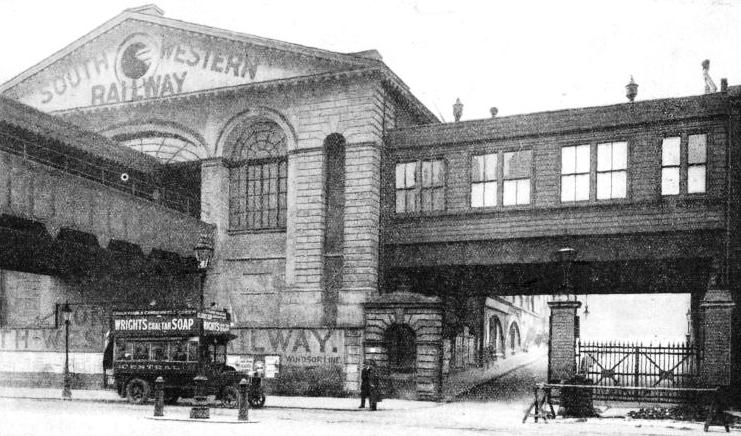
WATERLOO STATION IN 1910 was the terminus of the London and South Western Railway, the largest of the constituent railways embodied in the amalgamation of the Southern group. The LSWR had a route mileage of 1,019.
The London, Brighton and South Coast system serves such centres as Eastbourne, Worthing, Chichester, Hastings, Tunbridge Wells, Portsmouth, and Newhaven. Portsmouth is not only a great naval centre, but also the chief gateway to the Isle of Wight; and Newhaven is an important Channel port. But it is with Brighton that the railway has always been most prominently associated. Indeed, if there is any town or city in the kingdom especially identified with a particular railway, it is Brighton, and it is not a mere matter of convenient abbreviation that caused the line to be known for so many years as the “Brighton Railway”. No one has in modern times ever thought of calling the South Western the “Southampton Railway”, or the Great Western the “Bristol Railway”, although as ports both those cities have an importance to which Brighton can lay no claim.
This is not the place for a description of the popular seaside resort, which, together with the adjoining Hove and Kemp Town, has a promenade over five miles in length. But we are concerned with the fact that as a passenger traffic centre there is nothing else quite like it. Its stations receive visitors every day of the year, and no other place so far distant from any capital city to which it is connected has so many season-
Season Ticket Traffic
This partiality for season tickets on the part of the inhabitants of Brighton is by no means of recent growth. As long ago as 1889 it was observed that “if on a given day all the season-
The distance from Victoria to Brighton Central Station is slightly under fifty-
Among the trains that complete the journey in the level hour is the “Brighton Belle”, one of the most celebrated expresses in the country. This train, formerly known as the “Southern Belle”, makes six journeys a day, three in either direction. The “Brighton Belle”, which is composed entirely of Pullman cars, and is now, of course, electrically driven, began to run under its former title on November 1, 1908. But Brighton within the hour was a feat regularly accomplished before then, since a “Pullman Limited” with the same timings had been put on as early as October, 1898. This train, however, ran only on Sundays, leaving Victoria at 11 am and returning from Brighton at 9 pm. The “Southern Belle”, which carried first-
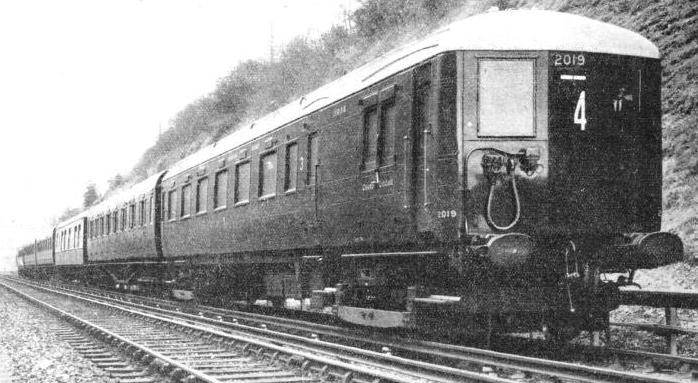
AN ELECTRIC EXPRESS, A six-
The first trip was made with a train composed of seven new Pullmans, hauled by an “Atlantic”. It “steamed out of Victoria Station with a company of distinguished passengers on board, and arrived at Brighton exactly one hour later”. On the coming-
The London and South Western is the largest of the four main systems forming the Southern, its route mileage of 1019 amounting to nearly half the total. It derived its origin from a scheme for constructing a ship canal from Southampton to London, to avoid the longer sea journey through the Straits of Dover to the Thames, The canal project materialized up to the point of a survey of the proposed route, which was, however, found to be impracticable because of its cost. A railway scheme was substituted in consequence; and in 1831 there was issued the prospectus of the Southampton, London and Branch Railway and Dock Company, which intended to build a dock at Southampton as well as a railway. The route selected was via Basingstoke, the reason for the choice of this indirect line being that the promoters also had in mind an extension from Basingstoke to Bath and Bristol.
The original scheme was abandoned, and in 1834 the London and Southampton Railway Company, which had dropped part of the original cumbrous title as well as the dock scheme, obtained from Parliament the permission to construct a railway seventy-
Short-
A rather unusual feature of the project was that it had the support of both the naval and military authorities. The first section, from Nine Elms (now the goods station) to Woking, was opened on May 21, 1838, and by June, 1839, the line had reached Southampton, though there was still a gap in the shape of the nineteen-
The system was built piecemeal. The section from Nine Elms to the present terminus at Waterloo was opened in 1848, the same year as the Fareham and Portsmouth line. Weymouth was reached in 1857, Exeter in 1860. The Seaton branch, in Devonshire, was opened in 1868. To describe the many other branches and extensions in the London district and outside would be tedious; but mention must be made of the Waterloo and City Railway, which was acquired by the London and South Western in 1898. The acquisition of this line, which has only two stations -
Despite the support of the naval and military authorities, the London and Southampton Company (the title of London and South Western was not adopted until 1839) had many critics and opponents at the start. Much of this criticism centred round the traffic possibilities of the line. The promoters had estimated that passenger, coal, and general goods and parcels traffic would bring in £111,000 a year, exclusive of £70,000 in respect of merchandise imported through Southampton, of which £20,000 related to “foreign fruits”. But opponents of the line declared that even this modest estimate was far too sanguine; one of them went so far as to assert that the railway would be used only for the conveyance of “parsons and prawns -
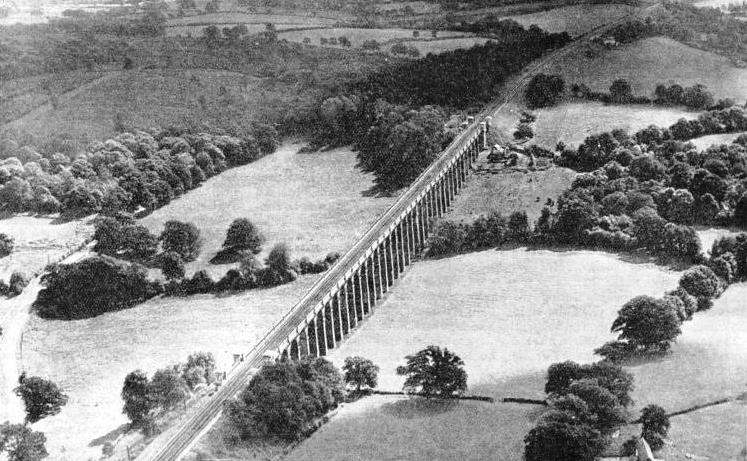
CARRYING THE MAIN LINE TO BRIGHTON. A splendid view of the Ouse Viaduct in Sussex on the Southern system. The track, now electrified, is carried at a maximum height of nearly 100 ft above the ground. The structure measures 1,475 ft in length.
Evidently this pessimist did not visualize the day when Southampton, so far from yielding a traffic exclusively composed of prawns, would become the premier ocean passenger port in the kingdom. It now handles over a third of the total traffic between Great Britain and places outside Europe, while London and Liverpool each deal with less than a quarter. But in those early days many people had curious ideas concerning railways, and it is on record that when the South Western obtained power to build its station at Wimbledon, a gentleman who had just agreed to buy an estate there “appealed to the generosity of the vendor to forgo a portion of the price, in consideration of the injury that must be done to the property”. It is said that the owner of the house did agree to a reduction of the figure.
The history of the London and South Western is largely bound up with competition with both the Brighton and Great Western systems. In connexion with the former, the construction of the Portsmouth branch led to what has been described as “exciting conflicts” with the Brighton’s employees; while the rivalry with the Great Western, which at one time extended also to the Channel Islands traffic, was accentuated in earlier days by the “Battle of the Gauges”, the South Western serving such broad-
The Fight for Traffic
The story, of this rivalry is too long to tell here, but reference must be made to one detail, the acquisition in 1845 of the little Bodmin and Wadebridge Railway, which, despite its short length -
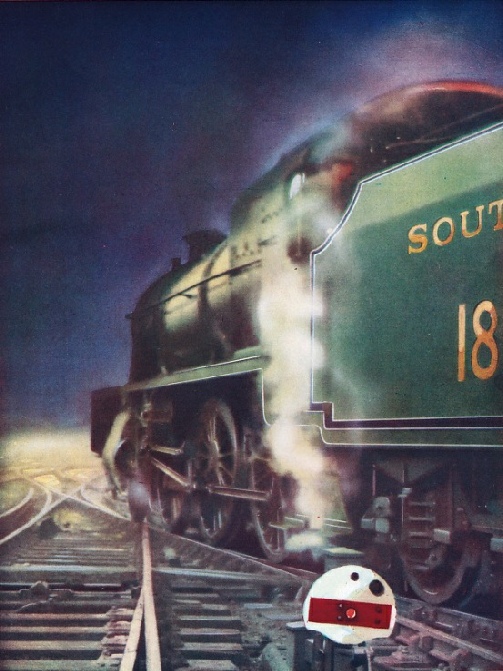
THE NIGHT JOURNEY. A mixed-
You can read more about “On the Footplate of a Night Goods”
While on the subject of competition we may also refer to the fight for traffic between two ports on the South Western. When the then London and Southampton Company undertook to give Portsmouth railway facilities by the construction of a branch to Gosport, leaving the main line at Bishopstoke, the scheme did not meet with the entire approval of the inhabitants of the port, who desired more direct communication with London. This attitude was not unconnected with the long-
We have very briefly traced the beginnings, development, and ramifications of the principal components of the Southern Railway, each of which would require a lengthy book to do real justice to its interesting history. The importance of Southampton has already been mentioned, but it should be noted that the port is one of the very few in the world with accommodation both for berthing and overhauling the largest liners afloat. Moreover, its size can be gauged by the fact that it has 30,068 ft of quay length, as compared with 3,932 at Folkestone and 5,215 at Newhaven. Indeed, the quay length at Southampton amounts to five-
Mention of Folkestone and Newhaven is a reminder that in addition to its ocean-
The Queen, which was placed on the cross-
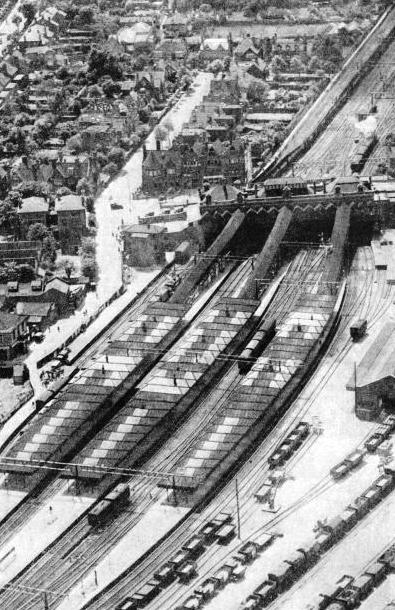 As Southampton is the premier passenger port for long-
As Southampton is the premier passenger port for long-
EAST CROYDON STATION. An aerial view of the important Surrey junction on the Southern system, some ten miles from Victoria. It lies on the main line of the Central Section, formerly London, Brighton and South Coast Railway. The present station was built in 1897-
In addition to its size, Waterloo possesses another distinction because of its position south of the Thames. The London and South Western was the only main line entering London without a terminus on the north side of the Thames. That the line did not go beyond the Surrey side was due to financial considerations. The extension from Nine Elms to Waterloo was enormously expensive; and, although the station was not intended to be a terminus, and much of the necessary land and property had been bought for a further extension, and the company had planned to acquire Southwark Bridge, a financial crisis intervened. Thus the terminus remained at Waterloo. In size, this station is closely approached by Clapham Junction, which occupies an area of twenty-
With the exception of the London-
The main line on the Chatham and Dover section is the steepest out of London, and has the added handicap of being composed of a constant series of switchbacks. Locomotives are most severely taxed on the up journey: immediately on leaving Dover there is a “bank” of 1 in 105, and a further rise of 1 in 132 to the summit at Shepherd’s Well, six and a half miles out; while from Canterbury to Selling there is a five-
Famous Engineers
Moreover, the Ramsgate-
It will be realized that such a combination of steep inclines and short runs does not make for the highest speeds, and the Southern’s locomotive working is far more creditable than it may appear on paper. The system has been fortunate in a series of talented locomotive engineers, among whom must be mentioned William Adams, Dugald Drummond, and R. W. Urie, of the South Western; James Cudworth, James Stirling, and William Kirtley, of the South Eastern and Chatham lines; William Stroudley and D. Earle Marsh, of the Brighton. The present Chief Mechanical Engineer, Mr. R. E. L. Maunsell, has already done much to standardize the number of types in service.
Among other Southern types may be singled out Wainwright’s standard 4-
The Southern’s electrification is the largest scheme of its kind in the world. Including the Hastings and Eastbourne extensions in hand, the electrified route mileage will amount to 447, which is equivalent to 1,147 miles of track. In addition to being the largest suburban electric system in existence, this conversion is the first main line electrification in Britain.

A “SCHOOLS” CLASS ENGINE. These 4-
You can read more about “The Atlantic Coast Express”, “The Golden Arrow”, “On the Footplate of a Night Goods” and The Thirties, Southern Railway” on this website.